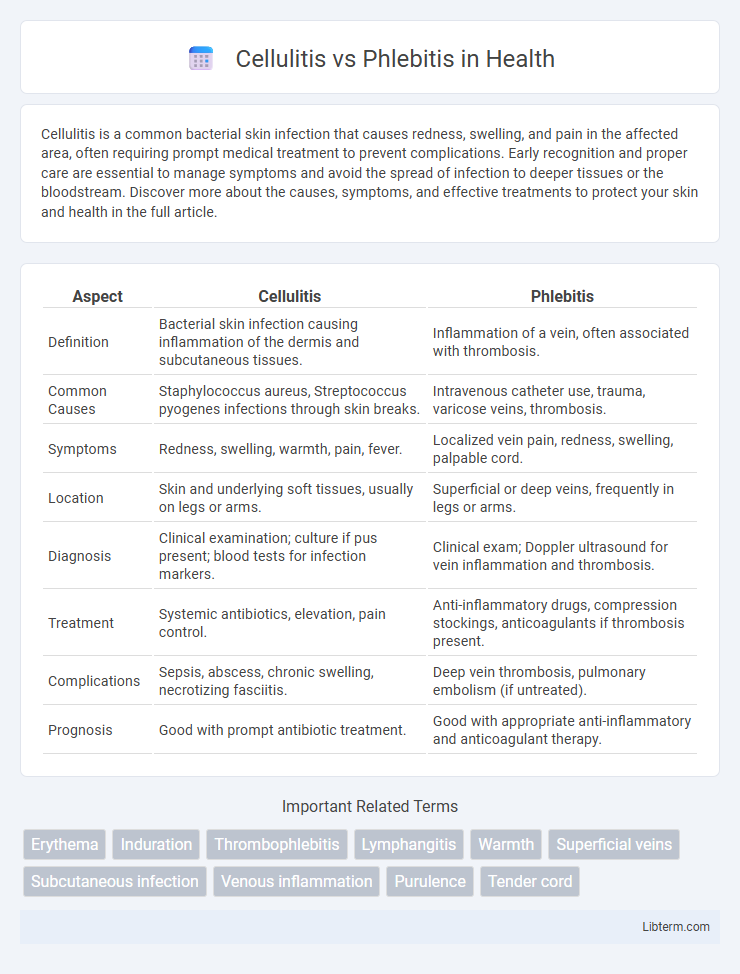Cellulitis is a common bacterial skin infection that causes redness, swelling, and pain in the affected area, often requiring prompt medical treatment to prevent complications. Early recognition and proper care are essential to manage symptoms and avoid the spread of infection to deeper tissues or the bloodstream. Discover more about the causes, symptoms, and effective treatments to protect your skin and health in the full article.
Table of Comparison
| Aspect | Cellulitis | Phlebitis |
|---|---|---|
| Definition | Bacterial skin infection causing inflammation of the dermis and subcutaneous tissues. | Inflammation of a vein, often associated with thrombosis. |
| Common Causes | Staphylococcus aureus, Streptococcus pyogenes infections through skin breaks. | Intravenous catheter use, trauma, varicose veins, thrombosis. |
| Symptoms | Redness, swelling, warmth, pain, fever. | Localized vein pain, redness, swelling, palpable cord. |
| Location | Skin and underlying soft tissues, usually on legs or arms. | Superficial or deep veins, frequently in legs or arms. |
| Diagnosis | Clinical examination; culture if pus present; blood tests for infection markers. | Clinical exam; Doppler ultrasound for vein inflammation and thrombosis. |
| Treatment | Systemic antibiotics, elevation, pain control. | Anti-inflammatory drugs, compression stockings, anticoagulants if thrombosis present. |
| Complications | Sepsis, abscess, chronic swelling, necrotizing fasciitis. | Deep vein thrombosis, pulmonary embolism (if untreated). |
| Prognosis | Good with prompt antibiotic treatment. | Good with appropriate anti-inflammatory and anticoagulant therapy. |
Understanding Cellulitis: Definition and Causes
Cellulitis is a common bacterial skin infection characterized by redness, swelling, warmth, and pain, typically caused by Streptococcus or Staphylococcus bacteria entering through breaks in the skin. Understanding its causes involves recognizing factors such as wounds, insect bites, or surgical incisions that allow bacteria to invade the dermis and subcutaneous tissues. Unlike phlebitis, which involves inflammation of veins, cellulitis primarily affects the skin's deeper layers and requires prompt antibiotic treatment to prevent spreading and complications.
What is Phlebitis? Overview and Triggers
Phlebitis is the inflammation of a vein, often occurring in the legs, caused by irritation, injury, or infection, leading to pain, swelling, and redness along the affected vein. Common triggers include intravenous catheter use, varicose veins, prolonged immobility, and trauma to the vein wall. Differentiating phlebitis from cellulitis is essential, as phlebitis primarily involves vein inflammation whereas cellulitis affects the skin and subcutaneous tissues.
Key Differences Between Cellulitis and Phlebitis
Cellulitis is a bacterial skin infection characterized by redness, swelling, and warmth, often caused by Streptococcus or Staphylococcus bacteria, whereas phlebitis involves inflammation of a vein, typically linked to blood clots or vein injury. Cellulitis affects the deeper layers of the skin and subcutaneous tissues, presenting symptoms such as pain, fever, and spreading redness, while phlebitis is marked by localized vein tenderness, redness along the vein, and sometimes a palpable cord. Diagnosis of cellulitis often requires clinical examination and sometimes cultures, whereas phlebitis diagnosis relies on ultrasound imaging to confirm vein inflammation or thrombosis.
Common Symptoms of Cellulitis
Cellulitis commonly presents with symptoms such as redness, swelling, warmth, and pain in the affected skin area, often accompanied by fever and chills. The infection typically causes diffuse skin inflammation and may lead to blistering or skin dimpling. Unlike phlebitis, which involves inflammation of veins, cellulitis primarily affects the deeper layers of the skin and subcutaneous tissues.
Typical Signs and Manifestations of Phlebitis
Phlebitis typically presents with localized redness, warmth, swelling, and tenderness along the course of a superficial vein, often accompanied by a palpable cord-like vein. Patients may experience pain or burning sensations at the affected site, with occasional mild fever or malaise. These signs differentiate phlebitis from cellulitis, which generally involves diffuse skin inflammation without vein involvement and presents with more extensive swelling and systemic symptoms.
Risk Factors for Developing Cellulitis vs. Phlebitis
Risk factors for developing cellulitis include skin injuries, chronic swelling (lymphedema), diabetes, and compromised immune systems, which facilitate bacterial entry and infection. Phlebitis risk factors primarily involve intravenous catheter use, varicose veins, prolonged immobility, and clotting disorders that contribute to vein inflammation and thrombosis. Both conditions are more common in individuals with obesity and older age, but cellulitis is strongly linked to bacterial skin breaches, while phlebitis is associated with vascular irritation and clot formation.
Diagnostic Methods: How Cellulitis and Phlebitis Are Identified
Diagnostic methods for cellulitis primarily include clinical examination focusing on skin redness, warmth, swelling, and tenderness, supported by laboratory tests such as elevated white blood cell count and C-reactive protein levels. Phlebitis diagnosis relies on ultrasound imaging, particularly Doppler ultrasound, to detect vein inflammation and rule out deep vein thrombosis, alongside clinical signs like localized pain and cord-like vein sensation. Blood cultures may be performed in both conditions to identify infectious agents and guide antibiotic therapy.
Treatment Options for Cellulitis and Phlebitis
Treatment options for cellulitis primarily involve systemic antibiotics such as cephalexin or clindamycin to target the bacterial infection. Phlebitis treatment focuses on anti-inflammatory medications, including NSAIDs, and applying warm compresses to reduce vein inflammation and pain. In cases of septic thrombophlebitis, intravenous antibiotics and possible anticoagulation therapy are necessary to prevent complications.
Possible Complications and Long-Term Effects
Cellulitis can lead to serious complications such as abscess formation, sepsis, and chronic swelling or lymphedema if left untreated. Phlebitis may cause thrombophlebitis, which increases the risk of deep vein thrombosis (DVT) and potentially life-threatening pulmonary embolism. Both conditions require prompt medical intervention to minimize long-term effects, including tissue damage and recurrent infections.
Prevention Strategies for Cellulitis and Phlebitis
Preventing cellulitis involves maintaining proper skin hygiene, promptly treating cuts or insect bites, and keeping skin moisturized to avoid cracking. For phlebitis prevention, focus on minimizing intravenous catheter use duration, ensuring sterile insertion techniques, and encouraging regular movement to improve circulation. Both conditions benefit from managing underlying risk factors such as diabetes and obesity to reduce inflammation and infection risk.
Cellulitis Infographic

 libterm.com
libterm.com